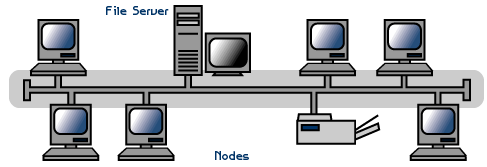|
Linear Bus

A linear bus topology consists of a main run of cable with a terminator at each end (See fig. 1). All nodes (file server,
workstations, and peripherals) are connected to the linear cable. Ethernet and LocalTalk networks use a linear bus topology.
Advantages of a Linear Bus Topology:
~ Easy to connect a computer or peripheral to a linear bus.
~ Requires less cable length than a star topology.
Disadvantages of a Linear Bus Topology
~ Entire network shuts down if there is a break in the main cable.
~ Terminators are required at both ends of the backbone cable.
~ Difficult to identify the problem if the entire network shuts down.
~ Not meant to be used as a stand-alone solution in a large building.
Star

A star topology is designed with each node (file server, workstations, and peripherals) connected directly to a central network
hub or concentrator (See fig. 2).
Data on a star network passes through the hub or concentrator before continuing to its destination. The hub or concentrator
manages and controls all functions of the network. It also acts as a repeater for the data flow. This configuration is common
with twisted pair cable; however, it can also be used with coaxial cable or fiber optic cable.
Advantages of a Star Topology
~ Easy to install and wire.
~ No disruptions to the network then connecting or removing devices.
~ Easy to detect faults and to remove parts.
Disadvantages of a Star Topology
~ Requires more cable length than a linear topology.
~ If the hub or concentrator fails, nodes attached are disabled.
~ More expensive than linear bus topologies because of the cost of the concentrators.
The protocols used with star configurations are usually Ethernet or LocalTalk. Token Ring uses a similar topology, called
the star-wired ring.
Star-Wired Ring
A star-wired ring topology may appear (externally) to be the same as a star topology. Internally, the MAU (multistation access
unit) of a star-wired ring contains wiring that allows information to pass from one device to another in a circle or ring.
The Token Ring protocol uses a star-wired ring topology.
Tree

A tree topology combines characteristics of linear bus and star topologies. It consists of groups of star-configured workstations
connected to a linear bus backbone cable (See Figure 3). Tree topologies allow for the expansion of an existing network, and
enable schools to configure a network to meet their needs.
Advantages of a Tree Topology
~ Point-to-point wiring for individual segments.
~ Supported by several hardware and software venders.
Disadvantages of a Tree Topology
~ Overall length of each segment is limited by the type of cabling used.
~ If the backbone line breaks, the entire segment goes down.
~ More difficult to configure and wire than other topologies.
Wireless LANs

Not all networks are connected with cabling; some networks are wireless. Wireless LANs use high frequency radio signals, infrared
light beams, or lasers to communicate between the workstations and the file server or hubs. Each workstation and file server
on a wireless network has some sort of transceiver/antenna to send and receive the data. Information is relayed between transceivers
as if they were physically connected. For longer distance, wireless communications can also take place through cellular telephone
technology, microwave transmission, or by satellite.
Wireless networks are great for allowing laptop computers or remote computers to connect to the LAN. Wireless networks
are also beneficial in older buildings where it may be difficult or impossible to install cables.
The two most common types of infrared communications used in schools are line-of-sight and scattered broadcast. Line-of-sight
communication means that there must be an unblocked direct line between the workstation and the transceiver. If a person walks
within the line-of-sight while there is a transmission, the information would need to be sent again. This kind of obstruction
can slow down the wireless network.
Scattered infrared communication is a broadcast of infrared transmissions sent out in multiple directions that bounces
off walls and ceilings until it eventually hits the receiver. Networking communications with laser are virtually the same
as line-of-sight infrared networks.
Wireless LANs have several disadvantages. They provide poor security, and are susceptible to interference from lights
and electronic devices. They are also slower than LANs using cabling.
Considerations When Choosing a Topology:
1. Money. A linear bus network may be the least expensive way to install a network; you do not have to purchase concentrators.
2. Length of cable needed. The linear bus network uses shorter lengths of cable.
3. Future growth. With a star topology, expanding a network is 4. Cable type. The most common cable in schools is unshielded
twisted pair, which is most often used with star topologies.
|

